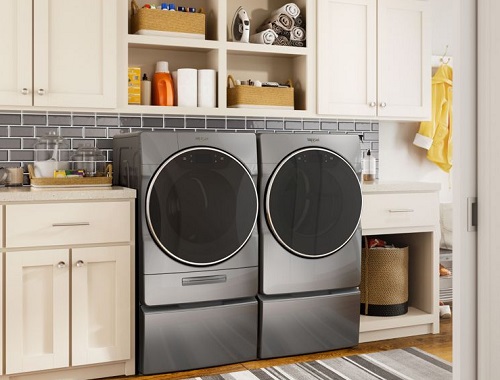
Welcome to our comprehensive Whirlpool Duet washer troubleshooting guide. If you’re facing issues with your Whirlpool Duet washer, you’re in the right place.
“Troubleshooting Made Easy with Whirlpool Duet!”
In this post, we’ll walk you through common problems and provide step-by-step solutions to get your appliance back in working order. Don’t let laundry day stress you out – let’s dive into the world of troubleshooting!
Whirlpool Duet Washer Troubleshooting Guide
Identifying the Problem Is your Whirlpool Duet washer acting up? Before we delve into specific troubleshooting steps, let’s start by identifying the problem. This step is crucial to ensure you apply the right fix to your appliance.
Whirlpool Duet Washer Troubleshooting Steps
Now that you’ve pinpointed the problem, it’s time to troubleshoot and resolve it. Follow these steps for a hassle-free solution:
1. Washer Not Starting
- Check the power source and ensure it’s plugged in securely.
- Examine the circuit breaker or fuse box for any tripped switches.
- Inspect the door latch – it should click when closed.
2. Washer Not Draining Properly
- Clear any obstructions from the drain hose.
- Check the drain pump for clogs or foreign objects.
- Ensure the drain hose is not kinked or bent.
3. Washer Leaking Water
- Inspect the door seal for tears or damage.
- Tighten any loose hose connections.
- Check the detergent dispenser for blockages.
4. Washer Making Unusual Noises
- Investigate for loose items inside the drum.
- Examine the drain pump for debris.
- Inspect the washer’s leveling feet for stability.
5. Washer Displaying Error Codes
- Refer to your user manual for error code explanations.
- Try resetting the washer by unplugging it for a few minutes.
- If the issue persists, contact customer support with the error code.
Preventative Maintenance Tips
To avoid future hassles with your Whirlpool Duet washer, consider these maintenance tips:
1. Regularly Clean the Washer
- Wipe down the door seal and drum to prevent mold growth.
- Run a cleaning cycle with vinegar or a specialized cleaner.
2. Use the Right Detergent
- Always use high-efficiency (HE) detergent to prevent oversudsing.
- Follow detergent manufacturer guidelines for proper usage.
3. Don’t Overload the Washer
- Overloading can strain the machine and lead to issues.
- Follow the recommended load size in the user manual.
Common Damaged Parts for Whirlpool Duet Washers
Whirlpool Duet washers, like any other appliance, can experience various issues and damage over time. Some common damaged parts or problems that you might encounter with Whirlpool Duet washers include:
- Door Seal or Gasket: The door seal or gasket can wear out or develop cracks, leading to water leaks.
- Water Inlet Valve: If the water inlet valve is faulty, the washer may not fill with water correctly, or it may not fill at all.
- Drain Pump: A malfunctioning drain pump can result in drainage issues, causing water to remain in the drum after a cycle.
- Door Lock Assembly: If the door lock or latch assembly fails, the washer may not start or complete a cycle.
- Pressure Switch: The pressure switch is responsible for detecting the water level in the drum. A faulty pressure switch can cause fill or drain problems.
- Control Board: Problems with the control board can lead to a range of issues, including cycle selection problems, error codes, or the washer not starting.
- Motor Control Board: The motor control board controls the washer’s motor and can cause issues like agitation problems or spin cycle failures when it malfunctions.
- Drive Belt: The drive belt connects the motor to the drum. If it breaks or becomes loose, it can cause the drum not to spin.
- Suspension Springs and Shock Absorbers: These parts help stabilize the drum during washing and spinning. Damaged springs or shock absorbers can result in excessive vibration or bouncing during cycles.
- Bearings: Worn-out drum bearings can lead to loud noises during the spin cycle.
- Pressure Hose: The pressure hose connects to the pressure switch and can develop leaks or blockages.
- Detergent Dispenser: The detergent dispenser can become clogged or malfunction, affecting the distribution of detergent and other laundry products.
- Hoses and Water Lines: Leaking hoses or water inlet lines can cause water leaks or flooding around the washer.
- Lint Filter: Clogs in the lint filter can affect water drainage and the overall performance of the washer.
- Tub Seal and Bearings: If the tub seal or bearings are damaged, they can cause water leaks and noisy operation.
- Heating Element: In some models, a faulty heating element can lead to problems with water temperature or drying.
- User Interface/Control Panel: Issues with the control panel or user interface can result in difficulty selecting cycles or responding to button presses.
- Lid Switch: On top-loading models, a malfunctioning lid switch can prevent the washer from starting.
- Thermal Fuse: A blown thermal fuse can disrupt power to the washer and prevent it from operating.
Keep in mind that diagnosing and repairing washing machine issues can be complex. It’s often best to consult the Whirlpool user manual, seek professional appliance repair services, or contact Whirlpool customer support for guidance and assistance when dealing with specific problems.
You May Need These Washer Parts:
Troubleshooting your Whirlpool Duet washer doesn’t have to be daunting. By following the steps and tips outlined in this guide, you can address common issues and keep your appliance running smoothly. Remember, regular maintenance is key to prolonging the life of your washer.
Say goodbye to laundry day worries and enjoy the convenience of your Whirlpool Duet washer once again. If you have any questions or need further assistance, feel free to reach out to our expert team – we’re here to help you!
Note: You can find more washer troubleshooting guides here.

